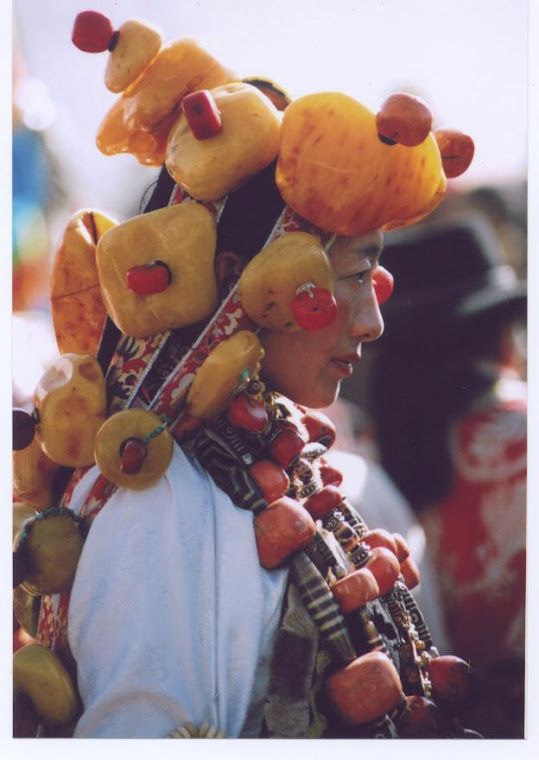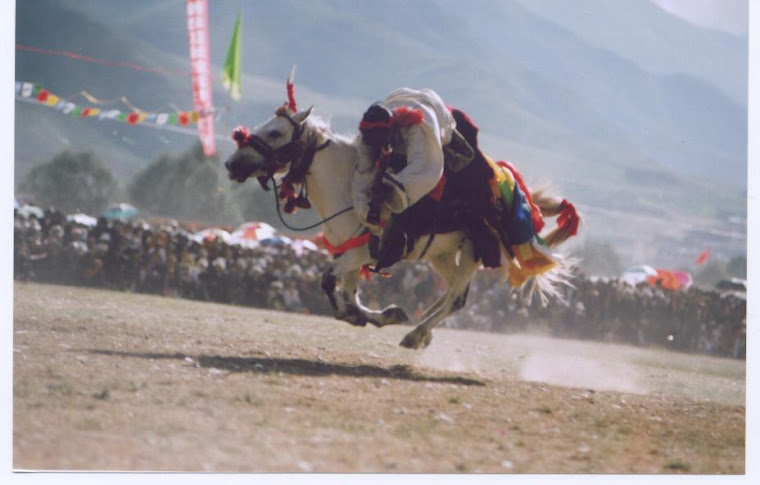
Tibet's oldest spiritual tradition is Bön. According to Bönpo accounts, eighteen enlightened teachers will appear in this aeon and Tönpa Shenrab, the founder of the Bön religion, is the enlightened teacher of this age. He is said to have been born in the mythical land of Olmo Lung Ring, whose location remains something of a mystery. The land is traditionally described as dominated by Mount Yung-drung Gu-tzeg (Edifice of Nine Swastikas), which many identify as Mount Kailash in western Tibet. Due to the sacredness of Olmo Lung Ring and the mountain, both the counter-clockwise swastika and the number nine are of great significance in the Bön religion.
It is believed that Tönpa Shenrab first studied the Bön doctrine in heaven, at the end of which he pledged at the feet of the god of compassion, Shenla Okar, to guide the people of this world. Accordingly, at the age of thirty one he renounced the world and took up a life of austerity, spreading the doctrine in order to help the beings immersed in an ocean of misery and suffering. In his effort to spread the doctrine, he arrived in Tibet, in the region of Mount Kailash, which is known as the land of Zhang Zhung, historically the principal seat of Bön culture and doctrine. Accounts of Tönpa Shenrab's life are to be found in three major sources; mDo-'dus, gZer-migand gZi-brjid. The first two are believed to be Treasure texts (gTer-ma) discovered according to Bön history in the tenth or eleventh century. The third belongs to the whispered lineage (sNyan-brgyud) transmitted amongst adepts.
The doctrines taught by Tonpa Shenrab are generally classified into two types, first, The Four Portals and One Treasury (sGo-bzhi mDzod-lizga): the White Water (Chabdkar) doctrine dealing with esoteric matters; the Black Water (Chab-nag)doctrine concerning narratives, magic, funeral rites and ransom rituals; the Land of Phan ('Phanyul) doctrine which contains monastic rules and philosophical expositions; the Divine Guide (dPon-gasa) doctrine containing exclusively the great perfection teachings; and finally, the Treasury (mTho-thog) which comprises the essential aspects of all the four portals.
The second classification, the Nine Ways of Bön (Bön theg-pa rim-dgu) is as follows: the Way of Prediction (Phyva-gshen Theg-pa), which describes sortilege, astrology, ritual and prognostication; the Way of the Visual World (sNang-shen theg-pa), which explains the psychophysical universe; the Way of Illusion ('Phrul-gshen theg-pa), which gives details of the rites for the dispersing adverse forces; the Way of Existence (Srid-gshen theg-pa), which explains funeral and death rituals; the Way of a Lay Follower (dGe-bsnyen theg-pa), which contains the ten principles for wholesome activity; the Way of a Monk, (Drnag-srnng theg-pa), in which the monastic rules and regulations are laid out; the Way of Primordial Sound (Adkar theg-pa), which explains the integration of an exalted practitioner into the mandala of highest enlightenment; the Way of Primordial Shen, (Ye-gshen theg-pa), which explains the guidelines for seeking a true tantric master and the spiritual commitments that binds a disciple to his tantric master; and, finally, the Way of Supreme Doctrine (Bla-med theg-pa), which discusses only the doctrine of great perfection.
The nine ways are further synthesised into three: the first four as the Causal Ways (rGyui-theg-pa), the second four as the Resultant Ways ('Brns-bu'i-theg-pa) and the ninth as the Unsurpassable Way or the Way of Great Completion (Khyad-par chen-po'i-theg-pa or rDzogs-chen). These are contained in the Bön canon comprising more than two hundred volumes classified under four sections: the sutras (mDa), the perfection of wisdom teachings ('Bum), the tantras (rGyud) and knowledge (mDzod). Besides these, the canon deals with other subjects such as rituals, arts and crafts, logic, medicine, poetry and narrative. It is interesting to note that the Knowledge (mDzod) section concerning cosmology and cosmogony is quite unique to Bön, though there is scholarly speculation that it has a strong affinity with certain Nyingma doctrines.
History has it that with the increasing royal patronage of Buddhism, Bön was discouraged, and faced persecution and banishment. Practically nothing is known about Bön during the period from the eighth to the early eleventh centuries. However, with the relentless devotion and endeavour of sincere followers such as Drenpa Namkha (9th century), Shenchen Kunga (10th century) and many others the Bön, Tibet's indigenous religion, was rescued from oblivion and re-established itself alongside Buddhism in Tibet. Since the eleventh century, with the founding of monasteries such as Yeru Ensakha, Kyikhar Rishing, Zangri and later Menri and Yungdrung Ling in Central Tibet; and Nangleg Gon, Khyunglung Ngulkar and others, more than three hundred Bön monasteries had been established in Tibet prior to Chinese occupation. Of these, Menri and Yungdrung monasteries were the major monastic universities for the study and practice of Bön doctrines. A reassessment of Bön took place in the nine-teenth century at the hands of Sharza Tashi Gyeltsen, a Bön master whose collected writings comprising eighteen volumes gave the tradition new impetus. His follower Kagya Khyungtrul Jigmey Namkha trained many disciples learned in not only the Bön religion, but in all the Tibetan sciences. However, with the Chinese invasion of Tibet, like the other spiritual traditions, Bön also faced irreparable loss.




















No comments:
Post a Comment